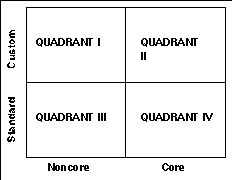|
Supplying Principles and Practices > USPS Supplying Practices Process Step 1: Identify Needs
Define and Understand Client Needs, Goals, and
Strategies
The Conceptualize Need task of Process Step 1: Identify Needs begins by
assessing Clients' needs, goals, and strategies. Clients' needs are unique
and are tailored to their business strategies, and it may be necessary for the
entire range of talents of the Purchase/SCM Team to be employed in helping
them make the most effective business decisions. Defining Clients' needs
requires the determination of what they want to achieve and whether the
solution they require can be achieved through the application of supply chain
management (SCM) business practices and related actions.
Interviews, discussions, and surveys are effective means of gaining further
understanding of Clients' needs, goals, and strategies. In addition to these
methods, performing research on the Client and its organization can help
identify strategic plans, tactical and operational goals, programs and projects,
capital budget projections, existing suppliers, and performance against
financial plans.
A good client relationship is based on understanding: what the Client values,
what is important to its organization, and how Supply Management (SM) can
help the Client meet its objectives.
Client focusing should be used to identify the products and services, quality
characteristics, and performance measures that are most important to the
Client's business. The main questions to be addressed and activities involved
in developing client focusing exercises are depicted in Figure 1.1.
Figure 1.1
Client Focusing

When Client needs, goals, and strategies have been identified, SM must
continue to work with the client to define requirements. Requirements are
categorized into groups, so clients with similar needs can be targeted
simultaneously. There may be occasions when it is not possible to reconcile
all requirements and Client expectations; in this case, as appropriate, SM
must work with the clients to resolve any outstanding issues.

A quadrant approach classifies all Postal Service purchases into four
categories, depending on their impact on the Postal Service core
competencies (noncore versus core) and complexities (standard versus
custom). The level and depth of understanding of Client needs, goals, and
strategies will vary depending on the complexity and criticality of the
purchase. Approaches to defining and understanding Client needs, goals,
and strategies will have to be aligned to the applicable quadrant, illustrated in
Figure 1.2.
Figure 1.2
Four Quadrants

Products and services in this quadrant do not provide direct value to the end
Client, but contribute significantly to the supporting capability function.
Clients' goals and strategies must be understood because they are
customized to the business function.
Products and services in this quadrant create direct value for the end Client;
there should be continuous work with these Clients to understand their
needs, goals, and strategies.
Products and services in this quadrant are essential to support the business
infrastructure, but do not relate or provide value to the end Client. These
Clients' objectives should be understood, but it is not necessary to spend
inordinate amounts of time conducting research or interviewing Clients in this
quadrant.

Products and services in this quadrant create value for the end Client and
may require leading-edge market solutions that do not need to be customized
exclusively to the business. Understanding Clients' expectations and needs
in this quadrant is important; therefore, a continuous communication plan
should be implemented.
|
